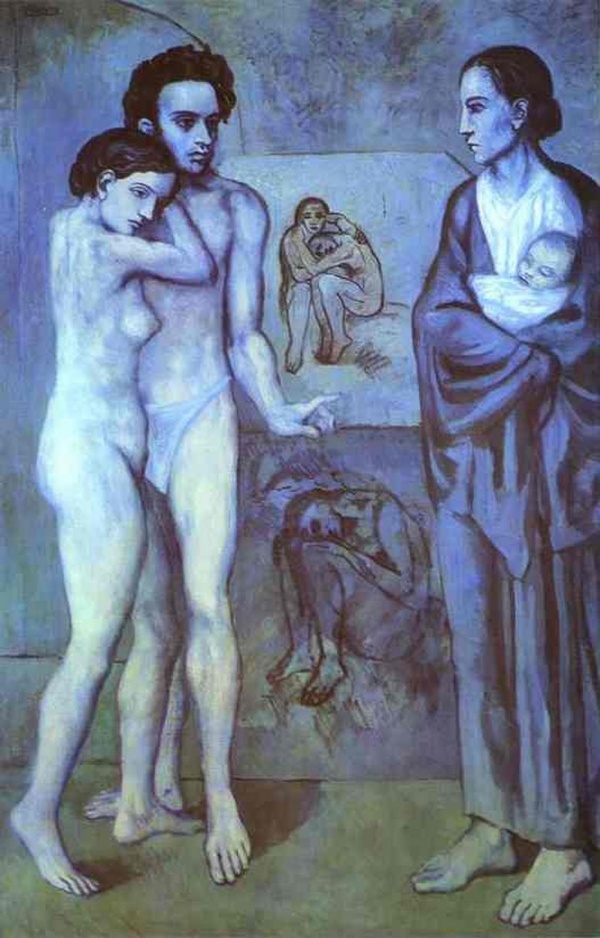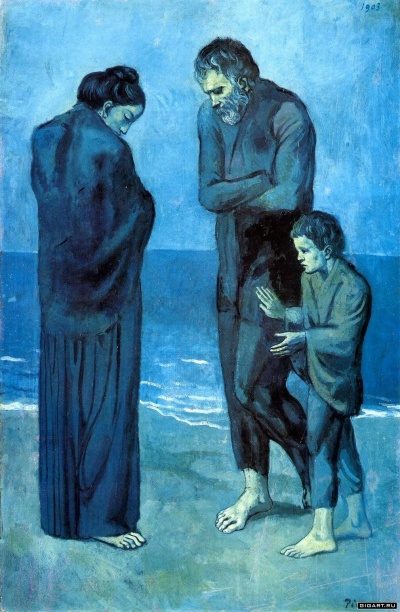Difference between revisions of "Reconstruction:La Vie (Picasso)"
Thaumasnot (talk | contribs) |
Thaumasnot (talk | contribs) |
||
| Line 13: | Line 13: | ||
[[File:Lavie-convex.png|center|frame|Asymmetric {{ref|convex}} shapes create an {{ref|opposition}} by “wrapping” the vertical group on the left]] | [[File:Lavie-convex.png|center|frame|Asymmetric {{ref|convex}} shapes create an {{ref|opposition}} by “wrapping” the vertical group on the left]] | ||
Then, the sight-line of the woman on the left, moving down the man’s left forearm and going up along the hand at an angle, forms a {{def|trajectory}} that emphasizes, as a tangent, the {{def|symmetric {{ref|convexity|convex}}|symmetry}} | Then, the sight-line of the woman on the left, moving down the man’s left forearm and going up along the hand at an angle, forms a {{def|trajectory}} that emphasizes, as a tangent, the {{def|symmetric {{ref|convexity|convex}}|symmetry}} made by the tonal contrast between the the mother cradling the baby and the mother’s dark clothing. | ||
[[File:Lavie-extern.png|center|frame|{{ref|Trajectory}} tangent to the {{ref|symmetric {{ref|convexity|convex}}|symmetry}}]] | [[File:Lavie-extern.png|center|frame|{{ref|Trajectory}} tangent to the {{ref|symmetric {{ref|convexity|convex}}|symmetry}}]] | ||
Latest revision as of 21:02, 12 January 2022
Two vertical groups the painting down the middle: the naked adult couple on the left, and the mother with baby on the right.
The top and bottom edges of the canvases in the background support horizontal bands. The uppermost band coincides with a between the man and woman to the right, thanks to the alignment of the horizontal sight-lines:
In the lower bands however, an is created between the vertical groups by the asymmetric shapes of the figures on the canvases who turn their back to the woman to the right:
Then, the sight-line of the woman on the left, moving down the man’s left forearm and going up along the hand at an angle, forms a that emphasizes, as a tangent, the made by the tonal contrast between the the mother cradling the baby and the mother’s dark clothing.
Together with the , this creates a link that goes through all four figures and subverts the based on the asymmetric shapes in the background and the rigid orthogonal lines that the painting.
Related painting: Des pauvres au bord de la mer
This painting uses a form of in the diagonal running along the woman’s forearm down the child’s right hand, the falling edge of his upper garment, and the man’s leg at an angle. The subverts their and the (underlined by the man’s crossed arms) between the woman and the man. The unites all three figures, as it parallels the vector made by the faces of the man and the child, as both faces nod the same way and tonally contrast the dark clothing.




